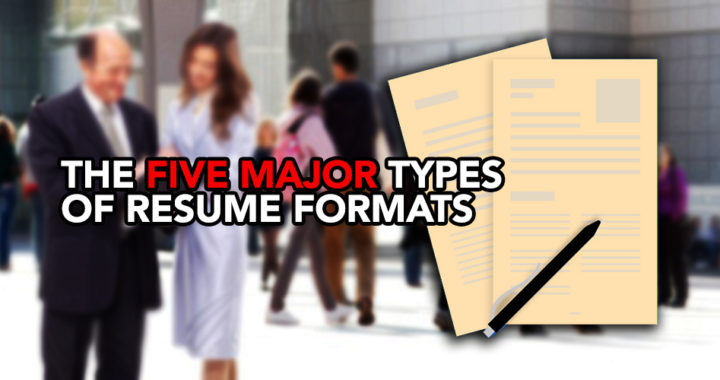No two resumes should be the same. Remember that the purpose of a resume is to grab the attention of employers and provide a precise overview of what an individual has accomplished and what he or she can further accomplish. For these reasons, professionals have become creative when it comes to writing and presenting information in their resumes, thus resulting to the emergence of different types of resume format.
The five major types of resume format
1. The Chronological Resume
The chronological resume is the standard and most commonly used type of resume format. It is primarily characterized by a chronological list and descriptions of work history, with the most recent job listed and described first. It also presents a chronological list of educational and professional development background, as well as community involvements in reverse order.
When to use: A chronological resume is suitable for individuals with strong and solid work history. Employers usually prefer this type of resume format because it allows them to readily scan the work-related accomplishments of a particular applicant, thus allowing them to easily match his or her capabilities with their requirements.
2. The Functional Resume
The functional resume or skills-based resume is a special type of resume format that focuses in the competencies or skills and knowledge acquired from professional and educational background. Thus, this resume is primarily characterized by a list and descriptions of competencies. Work history and educational or professional development background are presented as secondary contents, usually as concise lists with no additional descriptions or as supplementary information under the description of each item within the list of competencies.
When to use: A functional resume is ideal for individuals who have gaps in their work history or who have shifted across different career tracks and industries. This is also suitable for fresh graduates or inexperienced job seekers. However, some employers might find this type of resume confusing or unsuitable and most job websites do not support this resume format.
3. The Combination Resume
The combination resume is a hybrid of the chronological and functional resume formats. It is characterized by a detailed list and descriptions of competencies, coupled with a detailed list and/or descriptions of work history and educational or professional development background. There is no single format for organizing the information of a combination resume. An individual can present contents based on his or her preference or the requirements of the job he or she is applying for.
When to use: A combination resume is appropriate for individuals who have few variations in job positions occupied in the past due to short work history tenure or similarities in the job descriptions of previous jobs but have acquired relevant skills and knowledge, specifically a high degree of proficiency across different competencies.
4. The Targeted Resume
The target resume is another special type of resume format characterized by the limited presentation of information based on the requirements of a specific job vacancy, the characteristics of a particular position, and/or the characteristics of the employer. It essentially highlight the competencies, experiences, and other background that are relevant to the available job or position.
When to use: A targeted resume is highly recommended for everyone because it precisely presents a suitable amount of information, thus presenting an applicant as a perfect fit to a particular job vacancy or position. This resume format also promotes the unique selling proposition or differentiation of an applicant. However, it is important to maintain accuracy and refrain from embellishing the resume with inappropriate information.
5. The Creative Resume
The creative resume is a nontraditional type of resume format characterized primarily by the use visually appealing contents such as color theme, specialized layouts, pictures and graphs, and inforgraphics, among others. Textual contents to include list and descriptions of competencies, work history, and professional development background substantiate these graphical contents.
When to use: A creative resume is commonly used by professionals in commercial arts and other creative fields. Examples of these professionals are graphic artists, web developers, software usability specialists, writers and journalists, architects, and engineers.

